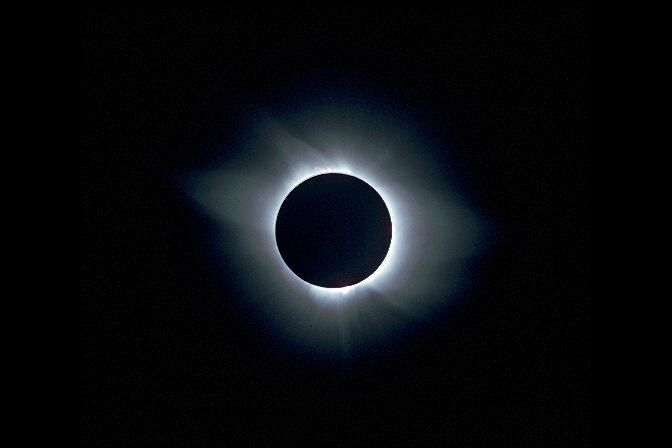For observers in the Canadian North, Greenland, the North Pole and parts of Russia, a full annular solar eclipse will be visible. The red band in the video depicts the ‘path of annularity’. Video credit: NASA Goddard Space Flight center.
What is an ‘Annular’ Eclipse?
As we know, a total solar eclipse occurs when the disk of the moon perfectly covers the solar disc. Since the moon is 400x closer than the sun yet 400x smaller, a perfect geometric cover occurs. Known as a ‘Ring of Fire’ eclipse, an annular eclipse occurs when the moon is slightly more distant in its orbit and thus, doesn’t perfectly cover the sun.
Why does the moon vary in apparent size?
As a consequence of gravity, all orbits in nature are elliptical, that is they’re not circular. This orbital path thus has the geometric properties of an ellipse: the distance separating the bodies in orbit varies according to the orbital period and thus, they have an apogee and a perigee. The apogee is the most distant point from the other gravitationally bound member of the system, the perigee is the closest point in the orbit.
During a solar eclipse with a long duration of totality (~7 minutes), the moon is close to or at perigee during the new moon phase, the only phase of the moon when a total solar eclipse can occur. When the moon is at or near apogee, it may not fully cover the sun and this is the case with the June 10th eclipse.
Next Apogee
Jun 7, 2021 at 10:27 pm
Distance: 406,228 km (252,418 mi)
Next Perigee
Jun 23, 2021 at 5:54 am
Distance: 359,956 km (223,666 mi)
Ephemerides courtesy of TimeAndDate.com
Can the Eclipse be Observed from the Continental United States?

Maximum partial eclipse for observers along the US Eastern Seaboard occurs a 5:32 AM, EDT, 13 minutes after sunrise! Image via Stellarium.
For observers along the Eastern Seaboard of the US to the Great Lakes region, the eclipse begins before sunrise at 4:38 AM, EDT with maximum eclipse occurring at 5:32 AM, EDT. Sunrise on June 10 occurs at 5:19 AM, EDT. The sun rises partially eclipsed by the moon with maximum eclipse occurring 13 minutest later! All observers in North America south of the Canadian border will witness a partial eclipse only; they will NOT see the annular phase of the eclipse. The eclipse ends at 6:31 AM, EDT. Full listing of other eclipse times can be found here.
Total solar eclipse of July 11, 1991 as imaged by the author in Cabo San Lucas, Mexico.
Astronomy For Change: https://astronomyforchange.org
Buy us a Coffee? https://www.buymeacoffee.com/astronomychange
Follow Us On Twitter: https://twitter.com/astronomychange
Why not support us on Patreon: https://www.patreon.com/astronomyforchange
Imagination is more important than knowledge
![]()
An index of all articles can be found here.
If you enjoyed this article, please consider supporting us with a modest donation
or through a subscription on our Patreon Page
Membership at Astronomy for Change is Free!




